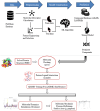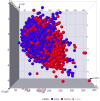Machine learning and molecular docking prediction of potential inhibitors against dengue virus
- PMID: 39776767
- PMCID: PMC11703810
- DOI: 10.3389/fchem.2024.1510029
Machine learning and molecular docking prediction of potential inhibitors against dengue virus
Abstract
Introduction: Dengue Fever continues to pose a global threat due to the widespread distribution of its vector mosquitoes, Aedes aegypti and Aedes albopictus. While the WHO-approved vaccine, Dengvaxia, and antiviral treatments like Balapiravir and Celgosivir are available, challenges such as drug resistance, reduced efficacy, and high treatment costs persist. This study aims to identify novel potential inhibitors of the Dengue virus (DENV) using an integrative drug discovery approach encompassing machine learning and molecular docking techniques.
Method: Utilizing a dataset of 21,250 bioactive compounds from PubChem (AID: 651640), alongside a total of 1,444 descriptors generated using PaDEL, we trained various models such as Support Vector Machine, Random Forest, k-nearest neighbors, Logistic Regression, and Gaussian Naïve Bayes. The top-performing model was used to predict active compounds, followed by molecular docking performed using AutoDock Vina. The detailed interactions, toxicity, stability, and conformational changes of selected compounds were assessed through protein-ligand interaction studies, molecular dynamics (MD) simulations, and binding free energy calculations.
Results: We implemented a robust three-dataset splitting strategy, employing the Logistic Regression algorithm, which achieved an accuracy of 94%. The model successfully predicted 18 known DENV inhibitors, with 11 identified as active, paving the way for further exploration of 2683 new compounds from the ZINC and EANPDB databases. Subsequent molecular docking studies were performed on the NS2B/NS3 protease, an enzyme essential in viral replication. ZINC95485940, ZINC38628344, 2',4'-dihydroxychalcone and ZINC14441502 demonstrated a high binding affinity of -8.1, -8.5, -8.6, and -8.0 kcal/mol, respectively, exhibiting stable interactions with His51, Ser135, Leu128, Pro132, Ser131, Tyr161, and Asp75 within the active site, which are critical residues involved in inhibition. Molecular dynamics simulations coupled with MMPBSA further elucidated the stability, making it a promising candidate for drug development.
Conclusion: Overall, this integrative approach, combining machine learning, molecular docking, and dynamics simulations, highlights the strength and utility of computational tools in drug discovery. It suggests a promising pathway for the rapid identification and development of novel antiviral drugs against DENV. These in silico findings provide a strong foundation for future experimental validations and in-vitro studies aimed at fighting DENV.
Keywords: dengue virus; drug discovery; machine learning; molecular docking; molecular dynamics simulation.
Copyright © 2024 Hanson, Adams, Kepgang, Zondagh, Tem Bueh, Asante, Shirolkar, Kisaakye, Bondarwad and Awe.
Conflict of interest statement
The authors declare that the research was conducted in the absence of any commercial or financial relationships that could be construed as a potential conflict of interest.
Figures









Similar articles
-
Identification and evaluation of bioactive compounds from Azadirachta indica as potential inhibitors of DENV-2 capsid protein: An integrative study utilizing network pharmacology, molecular docking, molecular dynamics simulations, and machine learning techniques.Heliyon. 2025 Feb 12;11(4):e42594. doi: 10.1016/j.heliyon.2025.e42594. eCollection 2025 Feb 28. Heliyon. 2025. PMID: 40051864 Free PMC article.
-
Investigating Lycotoxin-An1a (An1a), a defense antiviral peptide from Alopecosa nagpag venom as prospective anti-dengue agent against DENV-2 NS2B-NS3 protease.Comput Biol Chem. 2024 Feb;108:108005. doi: 10.1016/j.compbiolchem.2023.108005. Epub 2023 Dec 16. Comput Biol Chem. 2024. PMID: 38157660
-
Virtual screening of eighteen million compounds against dengue virus: Combined molecular docking and molecular dynamics simulations study.J Mol Graph Model. 2016 May;66:99-107. doi: 10.1016/j.jmgm.2016.03.008. Epub 2016 Mar 25. J Mol Graph Model. 2016. PMID: 27054972
-
Advances in Computational Methods to Discover New NS2B-NS3 Inhibitors Useful Against Dengue and Zika Viruses.Curr Top Med Chem. 2022;22(29):2435-2462. doi: 10.2174/1568026623666221122121330. Curr Top Med Chem. 2022. PMID: 36415099 Review.
-
Recent advances in natural products as potential inhibitors of dengue virus with a special emphasis on NS2b/NS3 protease.Phytochemistry. 2022 Oct;202:113362. doi: 10.1016/j.phytochem.2022.113362. Epub 2022 Aug 7. Phytochemistry. 2022. PMID: 35948138 Review.
Cited by
-
Computational insights into flavonoids inhibition of dengue virus envelope protein: ADMET profiling, molecular docking, dynamics, PCA, and end-state free energy calculations.PLoS One. 2025 Jul 9;20(7):e0327862. doi: 10.1371/journal.pone.0327862. eCollection 2025. PLoS One. 2025. PMID: 40632786 Free PMC article.
-
Targeting aldose reductase using natural African compounds as promising agents for managing diabetic complications.Front Bioinform. 2025 Feb 6;5:1499255. doi: 10.3389/fbinf.2025.1499255. eCollection 2025. Front Bioinform. 2025. PMID: 39996053 Free PMC article.
-
RareInsight simplifies the communication of genetic results for rare disease patients.Sci Rep. 2025 Jul 8;15(1):24442. doi: 10.1038/s41598-025-09744-y. Sci Rep. 2025. PMID: 40628872 Free PMC article.
-
Identification and evaluation of bioactive compounds from Azadirachta indica as potential inhibitors of DENV-2 capsid protein: An integrative study utilizing network pharmacology, molecular docking, molecular dynamics simulations, and machine learning techniques.Heliyon. 2025 Feb 12;11(4):e42594. doi: 10.1016/j.heliyon.2025.e42594. eCollection 2025 Feb 28. Heliyon. 2025. PMID: 40051864 Free PMC article.
References
-
- Abraham M. J., Murtola T., Schulz R., Pall S., Smith J. C., Hess B., et al. (2015). Gromacs: high performance molecular simulations through multi-level parallelism from laptops to supercomputers. SoftwareX 1–2, 19–25. 10.1016/j.softx.2015.06.001 - DOI
-
- Adams L., Afiadenyo M., Kwofie S. K., Wilson M. D., Kusi K. A., Obiri-Yeboah D., et al. (2023). In silico screening of phytochemicals from dissotisrotundifolia against plasmodium falciparum dihydrofolate reductase. Phytomedicine Plus 3 (2), 100447. 10.1016/j.phyplu.2023.100447 - DOI
LinkOut - more resources
Full Text Sources

